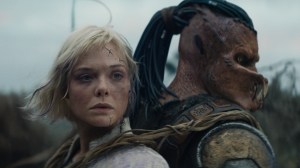It doesn’t take long for “I Am Frankelda,” a film being sold as Mexico’s first stop-motion feature, to show that it has a lot more going for it than a simple claim to fame. Our first clue is the introduction to the “Land of Spooks,” a fantasy realm parallel to the real world which influences human nightmares. It’s an absolute explosion of mixed media: Cardboard cutouts with 2D illustrations depict a castle spire as a bolt of lightning strikes, while a combination of painted and live-action insert shots punctuate the movements of the puppets. It’s an immediate glimpse into the boundless creativity of this first feature from Roy and Arturo Ambriz, brothers and co-founders of the production studio Cinema Fantasma.
Notably, the studio has some creative and financial backing from one Guillermo Del Toro, who recently released his own quasi-musical stop-motion fantasy, and whose love of the macabre can be felt in the Ambriz brothers’ own creative direction (not to mention the overlap between Del Toro’s new “Frankenstein” and the Mary Shelley-esque author at the heart of “Frankelda”). There’s a little bit of Henry Selick in here too (perhaps “The Nightmare Before Christmas” most of all), but the aforementioned interest in mixed media instantly begins to set the studio’s work apart, even as their movie flaunts its foundational influences.
The story of the film is actually a prequel, set prior to the events of the Cartoon Network Latin America series “Frankelda’s Book of Spooks,” which depicts mythical creatures from horror folk tales invading Earth from a realm where nightmares live; those tales are told by the titular Frankelda, a writer who also happens to be a ghost. Fortunately, ”I Am Frankelda” doesn’t really ask for any prior knowledge of the show, since it bypasses the episodes and dives directly into Frankelda’s past in the Land of Spooks.
It’s a realm in turmoil: the king and queen are shown to be dying due to a lack of good horror stories, and therefore a scarcity in the human nightmares on which they rely upon for sustenance. Originally known as Francisca Imelda, Frankelda becomes involved following the death of her mother, burying herself in writing original horror stories which unwittingly influence the other world in a mind-bending relationship between author and text – she creates Prince Herneval, a sort of humanoid owl monster, and seemingly influences his actions (à la “Stranger Than Fiction”), but the Prince influences her in return, a dynamic that becomes the foundation for a colorful story that sees art as a two-way street.
“Franked” suffers from some laborious exposition in the run-up to its best parts, as the Ambriz brothers take pains to establish the political intrigue of their film’s supernatural world, as well as the many concepts that undergird them. Concepts like the “Harpspider,” a gnarled tree-like musical instrument which conjures nightmares into the human world, the “Royal Nightmarer” who’s responsible for writing those nightmares, and then a variety of different factions who vie for control over these things — often working in opposition to the king and queen thanks to the schemes of the current Royal Nightmarer, an evil giant spider named Procustes. Good, then, that “Frankelda” enlivens the delivery of this information in myriad ways, such as gliding camerawork, astonishing production design, and even a musical sequence.
The Land of Spooks is a phantasmagorical blend of twisting gothic spires, impossible land formations, and disconcerting expressionist proportions. The creatures that dwell within it are even more impressive in their mechanical complexity and visual detail. The obsessive hand-crafted work in absolutely every aspect of the film speaks to its own message about the ecstasy of creating art and the messy relationship between author, audience, and text. The magic of “I Am Frankelda” lies in how its form speaks to its function, as the notion of art taking on a life of its own becomes more convincing when conveyed through puppetry this spectacular and lively.
There’s no overemphasizing how much color is packed into each frame, nor the production team’s palpable commitment to such tactile effects work. Smoke, an ocean of spooky fog (with hands!), clouds constructed from cotton wool; you can see the fur on Procustes boiling between shots, while one particularly ingenious effect sees the king partially fading into a kind of shimmering mist.
There’s only so much marveling at brilliant and grotesque creature designs that can be done before the story needs to get on its feet, but “I Am Frankelda” does eventually click into place once its world is the fully established, From there, the film settles into its ultimate groove as it digs into Frankelda’s anxieties about being a creator, and then Herneval’s guilt over his continual mistakes in his desperation to save his family, which is beautifully expressed through song. This is all to say that “I Am Frankelda” is bursting at the seams with ideas about the unruly and often distressing process of making truthful art, which are themselves expressed over the course of a film which is admirably purist in its craft at a time when animation is threatened by the phony digital grotesquery of AI. Through their tactile work, The Ambriz Brothers and their familial cohort of artists deal in a grotesquery of a far more appealing sort.
Grade: B+
“I Am Frankelda” screened at the 2025 Tokyo International Film Festival. It is currently seeking U.S. distribution.
Want to stay up to date on IndieWire’s film reviews and critical thoughts? Subscribe here to our newly launched newsletter, In Review by David Ehrlich, in which our Chief Film Critic and Head Reviews Editor rounds up the best new reviews and streaming picks along with some exclusive musings — all only available to subscribers.
